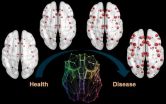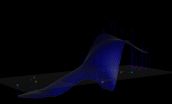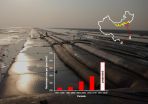(Press-News.org) Massachusetts General Hospital (MGH) investigators have developed a system to accurately track the dynamic process of falling asleep, something has not been possible with existing techniques. In their report in the October issue of the open-access journal PLOS Computational Biology, the research team describes how combining key physiologic measurements with a behavioral task that does not interfere with sleep onset gives a better picture of the gradual process of falling asleep. In addition to being a powerful tool for future research, the system could provide valuable insight into diagnosing and understanding sleep disorders.
The paper is available at http://www.ploscompbiol.org/article/info:doi/10.1371/journal.pcbi.1003866.
"While our personal experience tells us that falling asleep is a gradual process, current clinical methods only define a single point in time at which one has fallen asleep," says Michael Prerau, PhD, of the MGH Department of Anesthesia, Critical Care and Pain Management, lead author of the report. "Our new research shows that it's not simply when you fall asleep that's important, it's how you fall asleep that really matters. We now have the power to chart the entire trajectory of your neurological, physiological and behavioral activity as you transition from wake to asleep, rather than simply reporting the time it takes."
In their report, the investigators describe developing a method that continuously estimates the degree to which an individual is awake at each point during the sleep onset process. "This is a real paradigm shift in the way we study sleep onset," says Patrick Purdon, PhD, MGH Department of Anesthesia, Critical Care and Pain Management and senior author of the study. "By quantifying the dynamic changes in brain activity and behavior during the transition from wakefulness to sleep, we now have a rigorous framework with which to study disorders of sleep onset, such as insomnia or narcolepsy."
To link changes in brain activity to loss of consciousness during sleep onset, the investigators developed a new, minimally disruptive means of tracking behavior as someone falls asleep. Earlier methods either used tasks in which a participant was asked to respond to auditory cues, something that could disrupt falling asleep, or actigraphy - the method of measuring movement used in most clinical sleep devices and consumer wearables, which cannot distinguish between sleep and motionless wakefulness. To get around these problems the investigators developed an ingenious new behavioral task that is accurate without disturbing sleep.
Instead of responding to a sound, a participant holds a small rubber "stress ball" in one hand and is asked to squeeze the ball with every intake of breath and release it when exhaling. A special glove on that hand and electrodes on the forearm measure both the timing and the force of each squeeze. In this way, the participant's own breathing acts as the stimulus, and the squeezes act as the behavioral response. Tracking how well ball squeezes are aligned with an individual's breathing reflects a gradual process during which more and more squeezes are mistimed or totally absent. Measuring the force exerted by the forearm muscle also reflects how the strength of the squeezing motion drops with sleep onset.
At the same time as the ball-squeeze measurements are taken, EEG readings track three brain wave patterns previously associated with falling asleep, decreasing power in the alpha frequency range and increasing power in delta and theta frequencies. The combination of all of these measures - the timing and strength of ball squeezes and the change in brain wave levels - is used to calculate what the investigators call the wake probability, an estimate of the degree to which a participant is awake during the process of sleep onset.
Testing their model in healthy volunteers over several nights not only provided more accurate results than did traditional methods of sleep determination, it also revealed differences in the way sleep onset occurs in different individuals. Current clinical criteria define sleep as beginning when the power of an individual's alpha-range brainwaves disappears. While seven of the nine study participants followed this pattern, two participants continued to correctly time their ball squeezes for several minutes after alpha levels had dropped. Only when the power in their brainwaves at the theta and delta frequencies had risen did both the behavioral and physiological measures indicate that they were asleep.
"These participants continued to respond to the task, even though current clinical measures would say they were still asleep, which was clearly not the case," says Prerau. "These results suggest that it is the presence of delta and theta power, rather than the lack of alpha power, that is necessary for the cessation of behavior. We may need to carefully re-examine the way sleep onset is defined, since behavior is an essential component of the story that is not measured clinically."
By characterizing the trajectory of the sleep onset process in healthy individuals, Prerau and Purdon believe this study will ultimately shed light on what happens in patients who have trouble falling asleep, leading to an improved ability to understand and diagnose sleep disorders as well as to more precisely measure the effect of sleep medications. This method could also be used to track drowsiness in situations in which alertness is vital.
INFORMATION:
Prerau is an instructor of Anæsthesia, and Purdon is an assistant professor of Anæsthesia at Harvard Medical School. Additional co-authors are Katie Hartnack, Gabriel Obregon-Henao and Aaron Sampson, MGH Anesthesia; Margaret Merlino, Karen Gannon and Matt Bianchi, MD, PhD, MGH Department of Neurology; and Jeffrey M. Ellenbogen, MD, Johns Hopkins University. The study was supported by National Institutes of Health New Innovator Award DP2-OD006454.
Massachusetts General Hospital, founded in 1811, is the original and largest teaching hospital of Harvard Medical School. The MGH conducts the largest hospital-based research program in the United States, with an annual research budget of more than $785 million and major research centers in AIDS, cardiovascular research, cancer, computational and integrative biology, cutaneous biology, human genetics, medical imaging, neurodegenerative disorders, regenerative medicine, reproductive biology, systems biology, transplantation biology and photomedicine.
New findings by a Johns Hopkins University-led team reveal long unknown details about carbon deep beneath the Earth's surface and suggest ways this subterranean carbon might have influenced the history of life on the planet.
The team also developed a new, related theory about how diamonds form in the Earth's mantle.
For decades scientists have had little understanding of how carbon behaved deep below the Earth's surface even as they learned more and more about the element's vital role at the planet's crust. Using a model created by Johns Hopkins geochemist Dimitri ...
Twenty-five years ago this month, the countries that compose the United Nations reached a landmark agreement that laid the foundation for much-needed strengthening of children's rights and protections in nearly every country around the world.
Today, the Convention on the Rights of the Child remains the only formal global effort to improve children's rights and the most widely ratified human rights treaty in history. Only three U.N. member nations have not ratified the treaty: Somalia, South Sudan and the United States.
"The Convention on the Rights of the Child is a ...
Ebola GP protein covers the virus' surface and is shed from infected cells during infection. A study published on November 20th in PLOS Pathogens reports that shed GP can trigger massive dysregulation of the immune response and affect the permeability of blood vessels
Ebola virus has seven genes. One of them, called GP, codes for two related proteins: a shorter secreted one and a longer one that spans the viral wall and sticks out of its surface. During virus infection, some of the surface GP is cut off by a human enzyme and is subsequently shed from infected cells. High ...
Researchers from the Montreal Neurological Institute have used a model inspired by patterns of epidemic disease spreading to map how misfolded proteins propagate within the brain.
Proteins which fail to configure correctly (misfolded proteins) are associated with aging and several human neurodegenerative diseases, such as Alzheimer's. In research published in this week's PLOS Computational Biology, Yasser Iturria Medina and colleagues analyze over 700 individual Amyloid-beta proteins imaging datasets to conclude that the propagation of these misfolded proteins, associated ...
An international team of researchers has shown that it may be possible to improve the effectiveness of the seasonal flu vaccine by 'pre-empting' the evolution of the influenza virus.
In a study published today in the journal Science, the researchers, led by the University of Cambridge, describe how an immunological phenomenon they refer to as a 'back boost' suggests that it may be better to pre-emptively vaccinate against likely future strains than to use a strain already circulating in the human population.
Influenza is a notoriously difficult virus against which to ...
RIVERSIDE, Calif. - Yellow fever is a disease that can result in symptoms ranging from fever to severe liver damage. Found in South America and sub-Saharan Africa, each year the disease results in 200,000 new cases and kills 30,000 people. About 900 million people are at risk of contracting the disease.
Now a research team led by a biomedical scientist at the University of California, Riverside has determined that the yellow fever virus, a hemorrhagic fever virus, replicates primarily in the liver. Therefore, other organ failures that often follow in people with the ...
During the development of mammals, the growth and organization of digits are orchestrated by Hox genes, which are activated very early in precise regions of the embryo. These "architect genes" are themselves regulated by a large piece of adjacent DNA. A study led by Denis Duboule, professor at the University of Geneva (UNIGE) and the Federal Institute of Technology in Lausanne (EPFL), Switzerland, reveals that this same DNA regulatory sequence also controls the architect genes during the development of the external genitals. The results published in Science magazine, indicate ...
If you are an active senior who wants to stay younger, keep on running.
A new study involving the University of Colorado Boulder and Humboldt State University shows that senior citizens who run several times a week for exercise expend about the same amount of energy walking as a typical 20-year-old.
But older people who walk for exercise rather than jog expend about the same amount of energy walking as older, sedentary adults, and expend up to 22 percent more energy walking than the 20-something crowd. The study, led by Humboldt State Professor Justus Ortega, was published ...
Animal teeth, bones and plant remains have helped researchers from Cambridge, China and America to pinpoint a date for what could be the earliest sustained human habitation at high altitude.
Archaeological discoveries from the 'roof of the world' on the Tibetan Plateau indicate that from 3,600 years ago, crop growing and the raising of livestock was taking place year-round at hitherto unprecedented altitudes.
The findings, published today in Science, demonstrate that across 53 archaeological sites spanning 800 miles, there is evidence of sustained farming and human ...
China's second great wall, a vast seawall covering more than half of the country's mainland coastline, is a foundation for financial gain - and also a dyke holding a swelling rush of ecological woes.
A group of international sustainability scholars, including Jianguo "Jack" Liu, director of Michigan State University's Center for Systems Integration and Sustainability, in a paper published today in Science magazine, outline the sweeping downsides of one of China's efforts to fuel its booming economy, downsides that extend beyond China.
China's coastal regions are only ...






